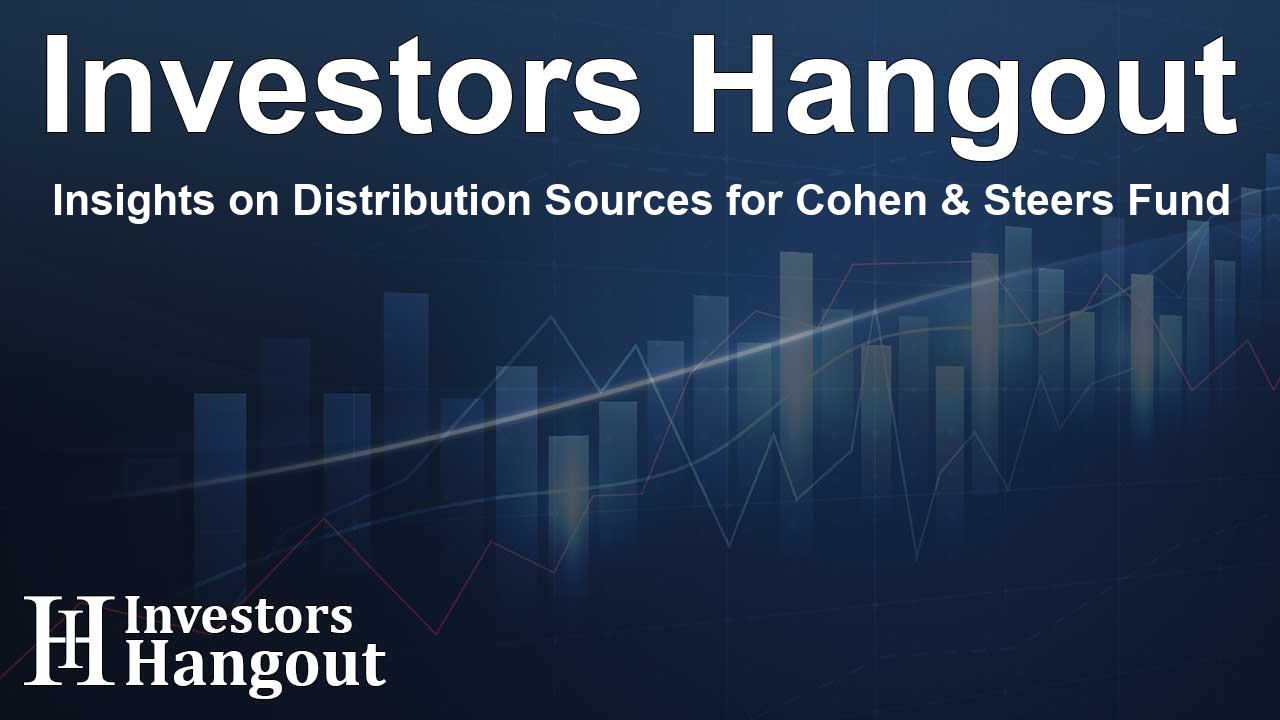Insights on Distribution Sources for Cohen & Steers Fund

Cohen & Steers Closed-End Opportunity Fund Distribution Notification
Cohen & Steers Closed-End Opportunity Fund, Inc. (NYSE: FOF) aims to keep its shareholders well-informed about the distribution sources. This communication clarifies the various channels of revenue contributing to the expected monthly distributions and provides an overview of fiscal performance year-to-date.
Understanding the Managed Distribution Policy
To better serve its investors, the Fund introduced a managed distribution policy, which was made operational with the support of regulatory entities. The essence of this policy lies in its objective to provide consistent monthly distributions, targeting a fixed rate per common share. This proactive strategy enhances the Fund's ability to appreciate in value through capital gains while ensuring that investors receive their earnings regularly throughout the financial year.
Flexibility and Potential Risks
The managed distribution policy supports the Fund in realizing long-term gains. However, it is crucial to note that the Board of Directors retains the authority to adjust, suspend, or even terminate this policy as deemed necessary. Such alterations could directly influence the market prices of the Fund's shares, thereby affecting shareholder value.
Components of Monthly Distributions
Monthly distributions made by the Fund can encompass various forms of revenue, including net investment income, long-term and short-term capital gains, along with potential returns of capital. Understanding these components is vital for shareholders as it affects how distributions are taxed. Specifically, returns of capital indicate distributions exceeding the Fund's net investment income, and this portion effectively decreases an investor’s tax basis.
Distribution Reporting and Transparency
Every month, the Fund is committed to maintaining transparency regarding the amounts distributed. Shareholders will receive a notice detailing the specifics of each distribution, which underscores the fluid nature of investment performance and the potential for changes in distribution amounts.
Current Distribution Estimates
To help investors gauge the current financial landscape, below is an overview of the distribution estimates for the current fiscal year, reflecting how various revenue streams contribute to overall distributions.
DISTRIBUTION ESTIMATES:
Current Distribution (March 2025)
- Net Investment Income: $0.0291 (33.45%)
- Net Realized Short-Term Capital Gains: $0.0102 (11.72%)
- Return of Capital: $0.0477 (54.83%)
This results in a total current distribution amounting to $0.0870 per common share, encapsulating the combined revenues from the aforementioned categories. Such breakdown is indispensable for shareholders to assess their returns and tax obligations accurately.
Performance Analysis
The year-to-date cumulative total return reflects how effectively the Fund is performing against the backdrop of its cumulative distribution rate. An analysis indicates that the average annual return over the last five years stands at approximately 9.17%, highlighting the Fund's commitment to generating substantial returns for its stakeholders.
Fund's NAV and Market Price
The Net Asset Value (NAV) plays a crucial role in assessing the value of a shareholder’s investment within the Fund. While NAV provides insights into the overall market value of the Fund's holdings, shares are traded in the market based on demand and supply, which could ultimately result in variations from the NAV.
Investor Considerations
By investing in the Fund, it's vital for investors to weigh the risks, investment objectives, fees, and associated expenses carefully. Informed decision-making is essential; therefore, it’s recommended that potential investors review periodic reports and regulatory filings to gain a comprehensive view of the Fund's operations.
Finally, based on IRS guidelines, shareholders will receive IRS Form 1099-DIV detailing the necessary information for tax reporting regarding distributions.
Frequently Asked Questions
What is the purpose of the managed distribution policy?
The managed distribution policy aims to provide consistent monthly cash flow to shareholders while allowing the Fund to realize long-term capital gains.
What are the components of the Fund's distributions?
The distributions may include net investment income, capital gains, and return of capital.
How is the Fund's performance measured?
The Fund's performance is primarily assessed through its Net Asset Value (NAV) and respective returns over specific periods, including year-to-date and average annual total returns.
What does a return of capital signify for investors?
A return of capital reduces an investor's tax basis in their shares and does not constitute taxable income.
How can shareholders stay informed about distributions?
Shareholders will receive periodic notices regarding distributions as well as access to information on the Fund’s website.
About The Author
Contact Evelyn Baker privately here. Or send an email with ATTN: Evelyn Baker as the subject to contact@investorshangout.com.
About Investors Hangout
Investors Hangout is a leading online stock forum for financial discussion and learning, offering a wide range of free tools and resources. It draws in traders of all levels, who exchange market knowledge, investigate trading tactics, and keep an eye on industry developments in real time. Featuring financial articles, stock message boards, quotes, charts, company profiles, and live news updates. Through cooperative learning and a wealth of informational resources, it helps users from novices creating their first portfolios to experts honing their techniques. Join Investors Hangout today: https://investorshangout.com/
The content of this article is based on factual, publicly available information and does not represent legal, financial, or investment advice. Investors Hangout does not offer financial advice, and the author is not a licensed financial advisor. Consult a qualified advisor before making any financial or investment decisions based on this article. This article should not be considered advice to purchase, sell, or hold any securities or other investments. If any of the material provided here is inaccurate, please contact us for corrections.
